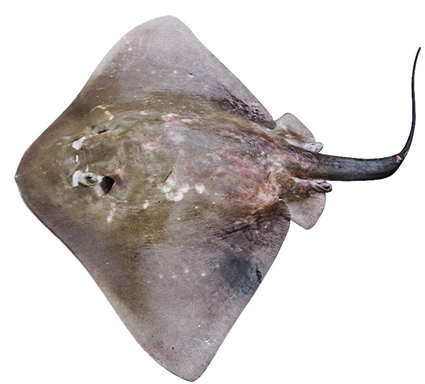Smalleye Stingray, Megatrygon microps (Annandale 1908)

Smalleye Stingray, Megatrygon microps. Source: Australian National Fish Collection, CSIRO. License: CC by Attribution-NonCommercial
Summary:
A very large stingray with the disc more than 1.4 times wider than long and covered in many large dermal denticles with star-shaped bases, especially on the snout. Disc brown to reddish-brown above, becoming slightly dusky at fin margins and darkening towards the tail tip, white below, with large white spots beside the eyes, around the middle of the disc, a row on either side across the disc to the pectoral fin tips and a row of small white spots on either side of the tail base.
The Smalleye Stingray is semipelagic and has been filmed flapping it's very wide pectoral fins up and down like butterfly and manta rays. Video of a Smalleye Stingray filmed off the coast of Mozambique.
This species was previously known as as Dasyatis microps.
The Smalleye Stingray is semipelagic and has been filmed flapping it's very wide pectoral fins up and down like butterfly and manta rays. Video of a Smalleye Stingray filmed off the coast of Mozambique.
This species was previously known as as Dasyatis microps.
Cite this page as:
Bray, D.J. 2019, Megatrygon microps in Fishes of Australia, accessed 01 Jul 2025, https://fishesofaustralia.net.au/home/species/2024
Smalleye Stingray, Megatrygon microps (Annandale 1908)
More Info
|
Distribution |
Recorded in Australia from the Northern Territory, and off Townsville, Queensland. Elsewhere, the species is widespread but uncommon in the Indo-west Pacific. Inhabits estuaries, river mouths and coastal waters, and may also be semi-pelagic in deeper areas. |
|
Biology |
Rreproductive mode - aplacental viviparous with the developing embryos sustained by yolk and later histotroph ("uterine milk") secreted by the mother. |
|
Fisheries |
Taken as incidental bycatch in demersal longline, bottom trawl, trammel net, and seine net fisheries throughout its range. |
|
Species Citation |
Trygon microps Annandale, 1908, Rec. Indian Mus. 2(4): 393, pl. 27. Type locality: Bay of Bengal, off Chittagong coast. |
|
Author |
Bray, D.J. 2019 |
|
Resources |
Smalleye Stingray, Megatrygon microps (Annandale 1908)
References
Annandale, N. 1908. A new sting ray of the genus Trygon from the Bay of Bengal. Records of the Indian Museum 2(4): 393-394. (as Dasyatis microps) See ref at BHL
Fowler, H.W. 1941. Contributions to the biology of the Philippine Archipelago and adjacent regions. The fishes of the groups Elasmobranchii, Holocephali, Isospondyli and Ostariophysi obtained by the United States Bureau of Fisheries Steamer Albatross in 1907 to 1910, chiefly in the Philippine Islands and adjacent seas. Bulletin of the United States National Museum 100(13): 1-879 figs 1-30 (as Dasyatis microps) See ref at BHL
Garman, S. 1913. The Plagiostomia (sharks, skates and rays). Memoirs of the Museum of Comparative Zoology, Harvard University 36: 1-528 pls 1-77 (as Dasyatis microps)
Larson, H.K., Williams, R.S. & Hammer, M.P. 2013. An annotated checklist of the fishes of the Northern Territory, Australia. Zootaxa 3696(1): 1-293
Last, P.R. & Stevens, J.D. 2009. Sharks and Rays of Australia. Collingwood : CSIRO Publishing Australia 2, 550 pp. (as Dasyatis microps)
Meekan, M.G., Trevitt, L., Simpfendorfer, C.A. & White, W. 2016. The piggybacking stingray. Coral Reefs 35(3): 1011. https://doi.org/10.1007/s00338-016-1429-9
White, W.T., Baje, L., Sabub, B., Appleyard, S.A., Pogonoski, J.J. & Mana, R.R. 2017. Sharks and Rays of Papua New Guinea. Australian Centre for International Agricultural Research Monograph Series 189: 1-327 Ref available online


